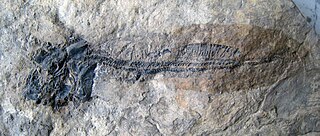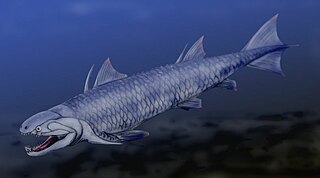
Chondrichthyes is a class of jawed fish that contains the cartilaginous fish or chondrichthyians, which all have skeletons primarily composed of cartilage. They can be contrasted with the Osteichthyes or bony fish, which have skeletons primarily composed of bone tissue. Chondrichthyes are aquatic vertebrates with paired fins, paired nares, placoid scales, conus arteriosus in the heart, and a lack of opecula and swim bladders. Within the infraphylum Gnathostomata, cartilaginous fishes are distinct from all other jawed vertebrates.

Holocephali, sometimes given the term Euchondrocephali, is a subclass of cartilaginous fish in the class Chondrichthyes. The earliest fossils are of teeth and come from the Devonian period. Little is known about these primitive forms, and the only surviving group in the subclass is the order Chimaeriformes.

Placodermi is a class of armoured prehistoric fish, known from fossils, which lived from the Silurian to the end of the Devonian period. Their head and thorax were covered by articulated armoured plates and the rest of the body was scaled or naked, depending on the species. Placoderms were among the first jawed fish; their jaws likely evolved from the first of their gill arches.

Cladoselache is an extinct genus of shark-like chondrichthyan from the Late Devonian (Famennian) of North America. It was similar in body shape to modern lamnid sharks, but was not closely related to lamnids or to any other modern (selachian) shark. As an early chondrichthyan, it had yet to evolve traits of modern sharks such as accelerated tooth replacement, a loose jaw suspension, enameloid teeth, and possibly claspers.

Dunkleosteus is an extinct genus of large arthrodire ("jointed-neck") fish that existed during the Late Devonian period, about 382–358 million years ago. It was a pelagic fish inhabiting open waters, and one of the first apex predators of any ecosystem.

Ctenurella is an extinct genus of ptyctodont placoderm from the Late Devonian of Germany. The first fossils were found in the Strunde valley in the Paffrather Kalkmulde.

Stethacanthus is an extinct genus of shark-like holocephalians which lived from the Late Devonian to Late Carboniferous epoch, dying out around 298.9 million years ago. Fossils have been found in Australia, Asia, Europe and North America.

Squalodon is an extinct genus of whales of the Oligocene and Miocene epochs, belonging to the family Squalodontidae. Named by Jean-Pierre Sylvestre de Grateloup in 1840, it was originally believed to be an iguanodontid dinosaur but has since been reclassified. The name Squalodon comes from Squalus, a genus of shark. As a result, its name means "shark tooth". Its closest modern relative is the South Asian river dolphin.
This glossary of ichthyology is a list of definitions of terms and concepts used in ichthyology, the study of fishes.

Gemuendina stuertzi is a placoderm of the order Rhenanida, of the seas of Early Devonian Germany. In life, Gemuendina resembled a scaly ray with an upturned head, or a large-finned stargazer. G. stuertzi is often invoked as an example of convergent evolution- with its flat body and huge, wing-like pectoral fins it has a strong, albeit superficial similarity to rays. Unlike rays, however, both Gemuendina`s eyes and nostrils were placed atop the head, facing upward. Furthermore, G. stuertzi's upturned mouth would have enabled it to suction prey that swam overhead, rather than swallow sediment or suction prey out of the substrate like modern rays.

Stensioella heintzi is an enigmatic placoderm of arcane affinity. It is only known from the Lower Devonian Hunsrück slate of Germany. The genus is named after Erik Stensiö, the species name honours Anatol Heintz.

Acanthothoraci is an extinct group of chimaera-like placoderms closely related to the rhenanid placoderms. Superficially, the acanthoracids resembled scaly chimaeras and (relatively) heavily armored ptyctodonts. They were distinguished from chimaeras by their large scales and plates, a pair of large spines that emanate from their chests, tooth-like beak plates, and the typical bone-enhanced placoderm eyeball. They were distinguished from other placoderms by differences in skull anatomy and by patterns on the skull plates and thoracic plates that are unique to this order.

Psarolepis is a genus of extinct bony fish which lived around 397 to 418 million years ago. Fossils of Psarolepis have been found mainly in South China and described by paleontologist Xiaobo Yu in 1998. It is not known certainly in which group Psarolepis belongs, but paleontologists agree that it probably is a basal genus and seems to be close to the common ancestor of lobe-finned and ray-finned fishes. In 2001, paleontologist John A. Long compared Psarolepis with onychodontiform fishes and refer to their relationships.

Materpiscis is a genus of ptyctodontid placoderm from the Late Devonian located at the Gogo Formation of Western Australia. Known from only one specimen, it is unique in having an unborn embryo present inside the mother, with remarkable preservation of a mineralised placental feeding structure. This makes Materpiscis the oldest known vertebrate to show viviparity, or giving birth to live young.

Incisoscutum is an extinct genus of arthrodire placoderm from the Early Frasnian Gogo Reef, from Late Devonian Australia. The genus contains two species I. ritchiei, named after Alex Ritchie, a palaeoichthyologist and senior fellow of the Australian Museum, and I. sarahae, named after Sarah Long, daughter of its discoverer and describer, John A. Long.

The evolution of fish began about 530 million years ago during the Cambrian explosion. It was during this time that the early chordates developed the skull and the vertebral column, leading to the first craniates and vertebrates. The first fish lineages belong to the Agnatha, or jawless fish. Early examples include Haikouichthys. During the late Cambrian, eel-like jawless fish called the conodonts, and small mostly armoured fish known as ostracoderms, first appeared. Most jawless fish are now extinct; but the extant lampreys may approximate ancient pre-jawed fish. Lampreys belong to the Cyclostomata, which includes the extant hagfish, and this group may have split early on from other agnathans.
Microbrachius is an extinct genus of tiny, advanced antiarch placoderms closely related to the bothriolepids. Specimens range in age from the Lower Devonian Late Emsian Stage to the Middle Devonian Upper Givetian Stage. They are characterized by having large heads with short thoracic armor of an average length of 2-4 cm. There are patterns of small, but noticeable tubercles on the armor, with the arrangement varying from species to species. Specimens of Microbrachius have been found in Scotland, Belarus, Estonia, and China.

Romundina is a small, heavily armored extinct genus of acanthothoracid placoderms which lived in shallow marine environments in the early Devonian (Lochkovian). The name Romundina honors Canadian geologist and paleontologist Dr. Rómundur (Raymond) Thorsteinsson of Calgary, Alberta, Canada. Romundina are believed to have lived on Earth between 400 and 419 million years ago. The closest known relative to Romundina is the acanthothoracid Radotina. The type and only described species is R. stellina.

Ptyctodus is an extinct armour-plated fish of the late Devonian. Ptyctodus belongs to the family Ptyctodontidae and is of the class Placodermi. They share a close resemblance to modern day chimaeras (Holocephali). Fossils of this armour-plated fish have been found in locations such as in Russia, the Michigan Basis, and Arizona, United States.

Kimbryanodus is a genus of extinct ptyctodontid placoderm fish from the Frasnian of Australia.These placoderms can be told apart from others due to the large eyes, crushing tooth plates, long bodies, reduced armor, and a superficial resemblance to holocephalid fish. The group is so far the only Placoderms known with sexually dimorphic features. The fossils occur as small three dimensional isolated plates. Because of these new specimens the Ptyctodontid grouping got a taxonomic classification, it found that the genus Rhamphodopsis to be the most basal taxa. They are divided by having the more basal taxa having a median dorsal spine, a simple spinal plate, and a simple V-shaped overlap of the anterior lateral and the anterior dorsolateral plates.























